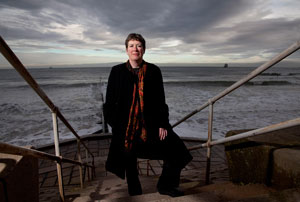
Photo: Optimized-Aberdeen-585×191
A tale of two cities
20 January 2013
by Richard Forster
The Scottish city of Aberdeen has thrived on oil and gas for the past 40 years but is reinventing itself as a global energy hub built on low-carbon principles and sustainability. ByJonathan Andrews
In a city that enjoys an unemployment rate of 2.3 percent, some of the highest average salaries in the United Kingdom, and with enough oil and gas deposits to last decades, one might wonder why Aberdeen is looking to transform itself into a low-carbon, sustainable, and renewable energy hub.
Aberdeen and the surrounding shire believe that its long-term economic prospects lie in a bold project called Energetica. It aims to create the world’s greatest concentration of energy technology companies, combined with new housing and leisure facilities. The 48-kilometre corridor will be based on low-carbon principles, running north from the city to the port of Peterhead, and venturing several kilometres inland.
“It’s long been recognised in the area, that we need to do more to consider the future beyond oil and gas,” says Derek McCrindle, Director of Energetica. “We need to ensure the area is able to capitalise on the investments we have here and to make sure those investments continue on from beyond the life of oil and gas.”
Aberdeen City and Shire Economic Forum (ACSEF), a public-private partnership that promotes economic growth for the city and shire, conceived Energetica after a comprehensive survey and consultative processs involving 1,800 businesses. Last year the Forum gave the green light for Energetica’s delivery plans.

“The companies we had engaged with were already investing heavily in research and development for solutions to oil and gas,” explains McCrindle. “There was a feeling that we should try and retain those businesses to make sure they dug deep roots into the area.”
Energetica’s delivery plan includes attracting businesses which promote and use renewable technologies, designing and retrofitting high quality and low-emission energy efficient buildings for business and residential use, improving transport networks that include low-emission technologies, increasing residential zones and providing 12,000 new highly energy efficient homes for key workers. Two key strategic environmental targets include an 80 percent reduction in carbon emissions by 2050 and an ecological impact reduction of 66 percent for new developments.
The second pillar of the project aims to tap into the skill base the region holds in offshore technologies. The Peterhead Development Zone seeks to deliver bespoke decommissioning of oil and gas rigs with those skills needed in renewable energy infrastructure. Included in this is the Energetica Industry Park, which will become a centre for technical innovation in the service and maintenance of renewable power generation.
“We are already one of the capitals in Europe for renewable energy,” adds McCrindle. “We also want to be recognised for low-carbon research and development, for renewables and manufacturing capabilities, and as a world-class centre for all aspects of the low-carbon community.”

Energetica boasts that over 30 percent of the potential £750 million (US$1.2 billion) investment in its 20 year vision is already underway, driven by major business park developments, which is attracting inward investment.
“There are now six projects running in parallel,” explains Rita Stephen, Development Manager, ACSEF. “These include studies into the use of geothermal combined heat and power, hydrogen, and carbon capture and storage, which together enable investigation into a range of ways to exploit all forms of energy in the corridor for both business and residential developments.”
A lifestyle corridor
Those with a key stake in Energetica, including Aberdeen City and Shire Councils, are eager to emphasise the holistic approach that the energy corridor entails, particularly the lifestyle angle in attracting companies, key workers and their families who not only come to Aberdeen for work, but who stay for generations. The council is also keen to mention a survey, conducted by the UK’s Office for National Statistics in July, that revealed Aberdeen’s citizens are the happiest in the UK.
“The nature of the corridor is unique as it’s not just about companies and technology,” says Elaine Robertson, Business Growth Manager, Enterprise, Planning and Infrastructure, Aberdeen City Council. “It’s a lifestyle corridor. The development focuses on housing, provision of education and healthcare services, and leisure facilities.”
One of those leisure facilities that Robertson refers to includes the Trump International Golf Links situated along the corridor and owned by US entrepreneur and billionaire, Donald Trump. Ironically while Trump generally supports the concept of Energetica he has vehemently opposed an 11-turbine wind farm which is to be developed offshore near the course. Additionally Trump, who flew into Aberdeen in October, personally threatened to not build the proposed hotel if the wind farm goes ahead.
Back in the heart of Aberdeen’s city centre another plan to attract workers and investment by promoting ‘quality of life’ recently failed. The £140 million City Garden Project was to replace a Victorian-era park in the centre of Aberdeen with a modern park and buildings, partially funded by local oil baron, Sir Ian Wood. While the plan was supported at a local referendum, Aberdeen City Council axed the idea in August after a closely fought vote, leaving many local business leaders feeling dismayed.
“Our poor city centre is often cited as a major obstacle in attracting people and investment,” says Sandy Clark, from engineering firm AMEC. “Other offshore provinces are overtaking us and unconventional oil and gas such as shale in places like North Dakota (USA) are now vying for our share of investment and talent. The city must have a vibrant attractive centre as a focal point for its many other quality of life attributes.”
McCrindle believes that the bad publicity from the gardens project can be countered by the council’s work in supporting a new western periphery road that will help open up the northeast of Scotland and improve logistical capabilities. Blighted by years of objections and legal challenges the road was given the go ahead in October after the UK Supreme Court rejected objections. “It will open up Aberdeen and the surrounding shire area for business in a way that will do more well beyond the gardens project,” says McCrindle.
Councils leading by example
Both the city and shire councils are eager to prove that their green credentials are not completely wrapped up in the Energetica project but are also leading the way in the region’s fight against climate change.
Aberdeen City Council was the first local authority in Scotland to develop an action plan for tackling climate change, and in 2009 signed up for a second time to the Local Authority Carbon Management Programme. It is lead partner on several European Union transnational projects that have brought funding to enhance the city’s environmental development.
Within council-owned assets the city is also undertaking energy efficient measures in installing low- or zero-carbon technologies.
“Where cities have a profile as an energy city it could be argued that it is encumbered on them to take a lead on climate change,” says Robertson, from Aberdeen City Council. “Those cities recognise that profiling themselves as an energy city, comes with a responsibility and that includes the development of a low-carbon economy and the long-term future.”
The pinnacle of the city’s ambitious plans includes the approval in August for Aberdeen to deploy Europe’s largest hydrogen bus fleet, as part of a £3.3 million European Union backed project for Aberdeen to become a clean energy hub.
By 2014 the city will see 10 hydrogen-fuel cell buses on its streets, producing only water vapour instead of other harmful emissions. Commenting at the announcement, Aberdeen City Council leader Barney Crockett said: “This initiative will stimulate further innovative hydrogen technology projects and attract even more high-level investment to this city. It is a crucial step towards Aberdeen becoming a world-leading, smart hydrogen city.”
Warnings
With the move from one form of energy to another, warnings are being sounded about a lack of diversification and questions raised concerning the councils’ commitment and funding.
Global advisory firm PwC produced a progress update in September following the publication of its Northern Lights report from 2011, which says while the city has made achievements in technical innovation there has been less progress on access to capital, realising renewable and decommissioning opportunities, and ensuring a ready supply of skilled labour. The report notes that by 2022 Aberdeen must attract around 120,000 new recruits if it is to realise its potential as a global energy capital.
“The supply of appropriately skilled labour continues to be the greatest threat to Aberdeen’s ability to become a global energy centre of excellence,” says Mark Higginson, Senior Partner, PwC. “Aberdeen can be dynamic, forward thinking and buoyant but we need to sell this vision to investors and future talent to help drive relocation to the city.”
A key cog in this is the setting up of an Aberdeen Energy Academy. McCrindle, from Energetica, says that talks are continuing with the Scottish Government, local universities and colleges in regard to funding.
“We are doing everything we possibly can to ensure it is based here,” he says. “The academy’s key role will be to bring people into this sector and area up to the northeast of Scotland to study, to live and enjoy a quality of life and to hopefully lay down long-term roots.”
Similarly the UK-based think-tank, Centre for Cities, while praising Aberdeen’s general economic performance and its movement away from over-dependence on oil and gas, warns that replacing oil and gas to become another single industry town has its own risks.
“It’s about diversity, across sectors and sizes of firms, and about maintaining that diversity so you are incubated from economic shocks,” says Rachel Smith, Analyst, Centre for Cities. “A city also needs to be realistic about what it can achieve. Because Aberdeen has such a highly skilled workforce a lot of firms are engaged in knowledge intensive, high-tech sectors, which is a massive bonus and will help the city as the oil and gas industry declines.”
Although other oil and gas cities such as Houston, USA, and Stavanger, Norway, have renewable energy strategies, and green city plans, Aberdeen’s is catching attention due to its long-term strategic planning and its all-encompassing nature. It aims to not only be an economic plan, but an environmental strategy that has an eye firmly focused on issues surrounding climate change.

“We all take the environment and climate change imperatives as read,” explains Morag McCorkindale, Chief Operating Officer, Aberdeen Renewable Energy Group. “Because our energy base is industrial we tend to come at it from that point of view. But alongside that we are also working with partners to deliver value to members of the community–not just through providing them with jobs. We live in a particularly beautiful country and we’d like to keep it that way.”









